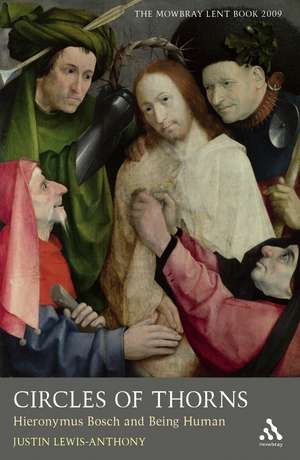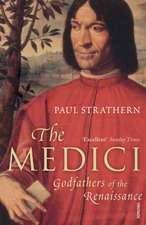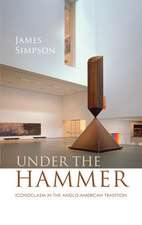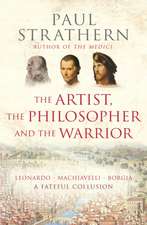Circles of Thorns: Hieronymus Bosch and Being Human
Autor The Revd Justin Lewis-Anthonyen Limba Engleză Paperback – 12 noi 2008
Unlike Bosch's better-known, fantastical, 'proto-surrealist' paintings, Christ Mocked is small, still and sombre, and yet, with a little effort of knowledge and interpretation, it reveals a depth of understanding of both the Passion, and of human nature, that speaks as much to the twenty-first century as it did to the sixteenth.
By exploring the political, scientific, psychological and devotional world of early modern Europe, and applying those insights to our own time, the author shows how Bosch used his sophisticated artistic skills to convey a similarly sophisticated understanding of humanity. In Christ Mocked -- a painting "500 years old but passionately modern" -- Christ's Passion is so portrayed as to make us reassess the cosmic significance of Christ's death, and its profound implications for what we think it means to be human.
By exploring the political, scientific, psychological and devotional world of early modern Europe, and applying those insights to our own time, the author shows how Bosch used his sophisticated artistic skills to convey a similarly sophisticated understanding of humanity. In Christ Mocked -- a painting "500 years old but passionately modern" -- Christ's Passion is so portrayed as to make us reassess the cosmic significance of Christ's death, and its profound implications for what we think it means to be human.
Preț: 84.05 lei
Preț vechi: 138.12 lei
-39% Nou
Puncte Express: 126
Preț estimativ în valută:
16.08€ • 16.85$ • 13.30£
16.08€ • 16.85$ • 13.30£
Carte tipărită la comandă
Livrare economică 12-26 aprilie
Preluare comenzi: 021 569.72.76
Specificații
ISBN-13: 9781906286217
ISBN-10: 1906286213
Pagini: 200
Ilustrații: 2
Dimensiuni: 129 x 198 x 19 mm
Greutate: 0.24 kg
Editura: Bloomsbury Publishing
Colecția Mowbray
Locul publicării:London, United Kingdom
ISBN-10: 1906286213
Pagini: 200
Ilustrații: 2
Dimensiuni: 129 x 198 x 19 mm
Greutate: 0.24 kg
Editura: Bloomsbury Publishing
Colecția Mowbray
Locul publicării:London, United Kingdom
Caracteristici
Builds on the 'Seeing Salvation' phenomenon (the National Gallery reported almost 4m visitors in 2005-6, with religious art one of the fastest-growing areas of interest)
Cuprins
The book follows five 'circles' around the painting (consciously evoking the circle of thorns held behind Christ's head). Each circle looks in turn at the subtexts of the painting, explored by Bosch:
(1) politics What is the interplay between religion and power, and what assumptions do we make about their relationship today?
(2) science, or elements What is the proper relationship of science and religion in our own day? Is Dawkins the last word on the matter, or does Bosch give us a way of expressing, with renewed confidence, a religious understanding of science?
(3) temperaments What challenge does Bosch's painting pose to our personality, and to our modern understanding of human psychology?
(4) devotions What was the spiritual atmosphere of Bosch's day, and how does it relate to our own?
(5) the final circle, Quiddity, centres on the still subject of the painting: Christ himself. It asks what meaning we can find in the Incarnation and Passion today, and shows how we can transform our understanding of trust and time and their implications for proclaiming the Gospel. The book is not a work of art history, although its art historical conclusions are sound. It draws on writers and artists from Thomas a Kempis to Terry Pratchett, and from St Bonaventure to Bob Dylan and Brian Eno to show how a painting "500 years old but passionately modern" can transform our understanding of what it means to be fully human.
(1) politics What is the interplay between religion and power, and what assumptions do we make about their relationship today?
(2) science, or elements What is the proper relationship of science and religion in our own day? Is Dawkins the last word on the matter, or does Bosch give us a way of expressing, with renewed confidence, a religious understanding of science?
(3) temperaments What challenge does Bosch's painting pose to our personality, and to our modern understanding of human psychology?
(4) devotions What was the spiritual atmosphere of Bosch's day, and how does it relate to our own?
(5) the final circle, Quiddity, centres on the still subject of the painting: Christ himself. It asks what meaning we can find in the Incarnation and Passion today, and shows how we can transform our understanding of trust and time and their implications for proclaiming the Gospel. The book is not a work of art history, although its art historical conclusions are sound. It draws on writers and artists from Thomas a Kempis to Terry Pratchett, and from St Bonaventure to Bob Dylan and Brian Eno to show how a painting "500 years old but passionately modern" can transform our understanding of what it means to be fully human.
Recenzii
"A many-layered analysis" - Catholic Herald
"This is a very good extended meditation on a specific moment in the Passion story; it is also a good example of the quality of patient, intelligent attention that is (or should be) much more fostered that it has been of late in Christian spirituality." - Church Times
'A gripping book which affirms the validity of the Passion to both the 16th and the 21st centuries as well as illustrating unchanging human nature.' Methodist Recorder, February 2009
Edited extracts in Church Times
"A heartfelt book about what it means to be fully human ... The reader is caught up into the painting's political message which is revealed as supremely modern." The Tablet, March 2009
"A fascinating and rewarding book." Baptist Times, February 2009
Mention in author's Church Times article, 'Trapped in temperament', 20 March 2009.
Mention in author's Church Times article, 'The flesh the Word took', 27 March 2009.
"This is a very good extended meditation on a specific moment in the Passion story; it is also a good example of the quality of patient, intelligent attention that is (or should be) much more fostered that it has been of late in Christian spirituality." - Church Times
'A gripping book which affirms the validity of the Passion to both the 16th and the 21st centuries as well as illustrating unchanging human nature.' Methodist Recorder, February 2009
Edited extracts in Church Times
"A heartfelt book about what it means to be fully human ... The reader is caught up into the painting's political message which is revealed as supremely modern." The Tablet, March 2009
"A fascinating and rewarding book." Baptist Times, February 2009
Mention in author's Church Times article, 'Trapped in temperament', 20 March 2009.
Mention in author's Church Times article, 'The flesh the Word took', 27 March 2009.





